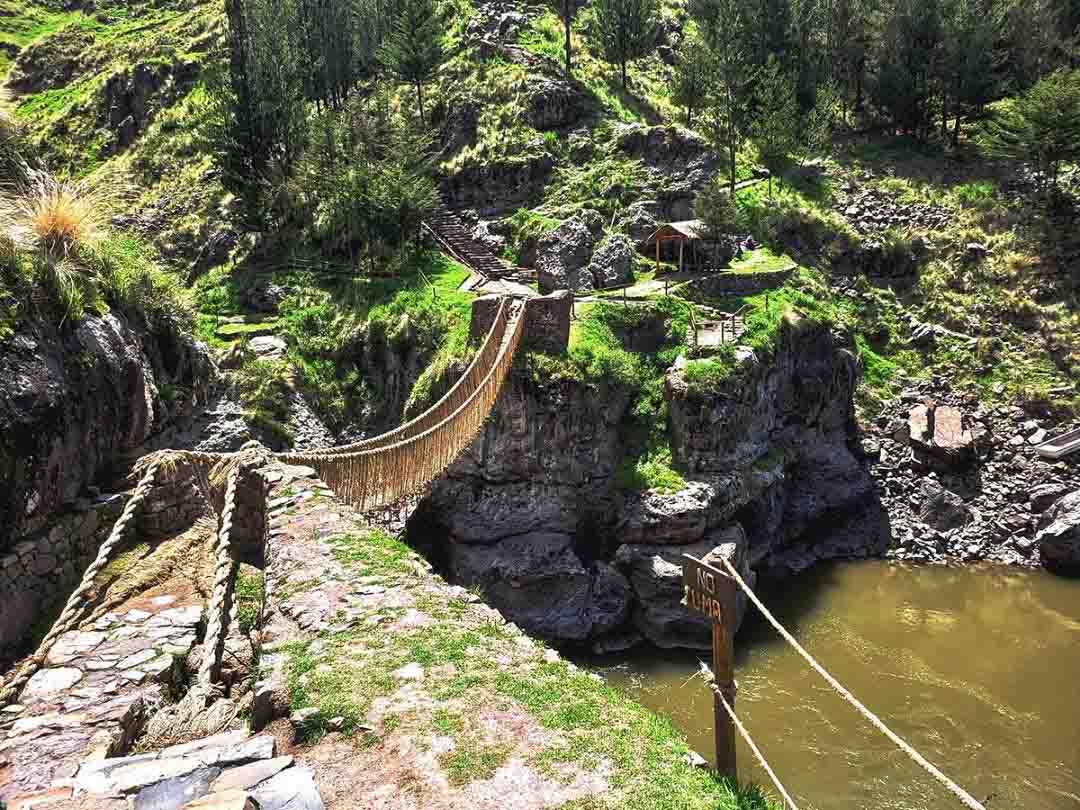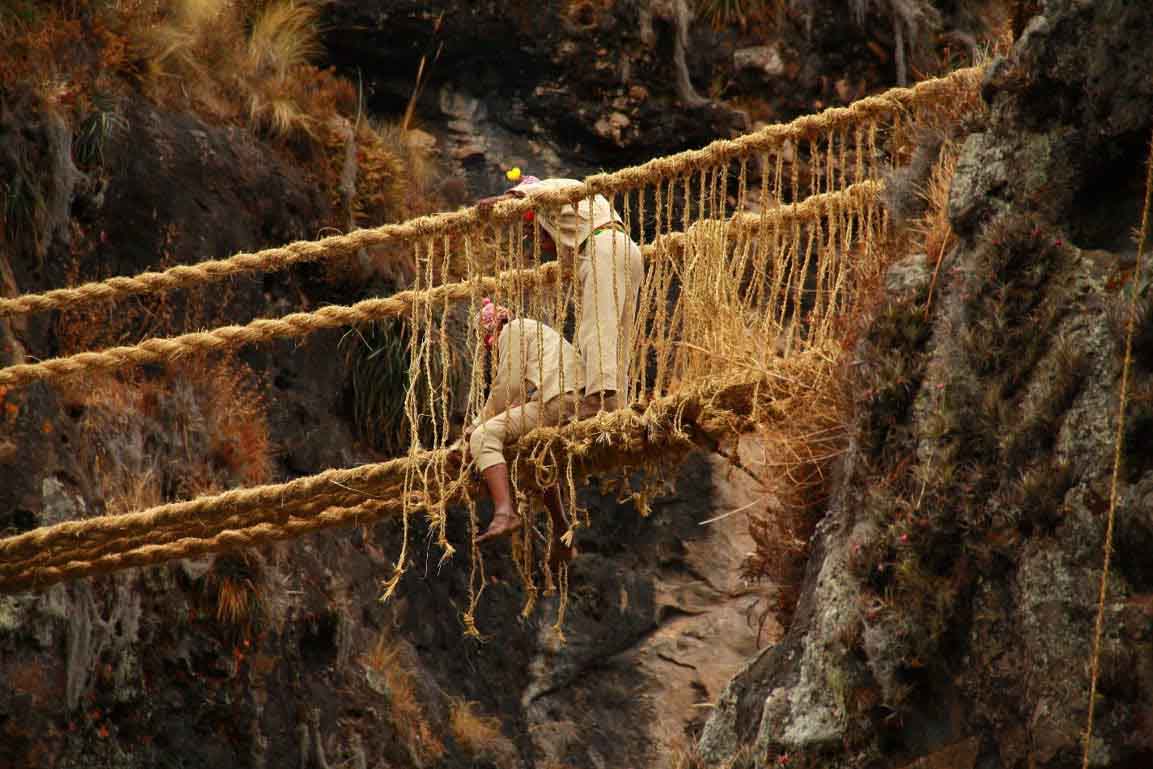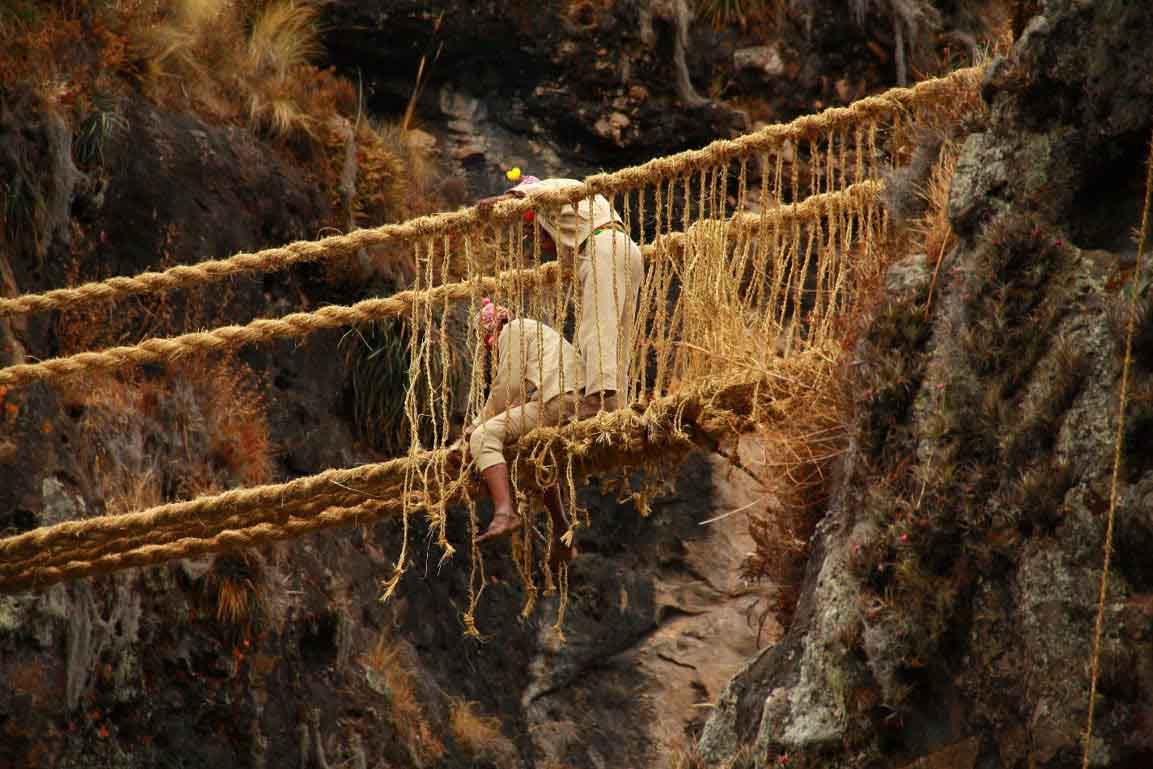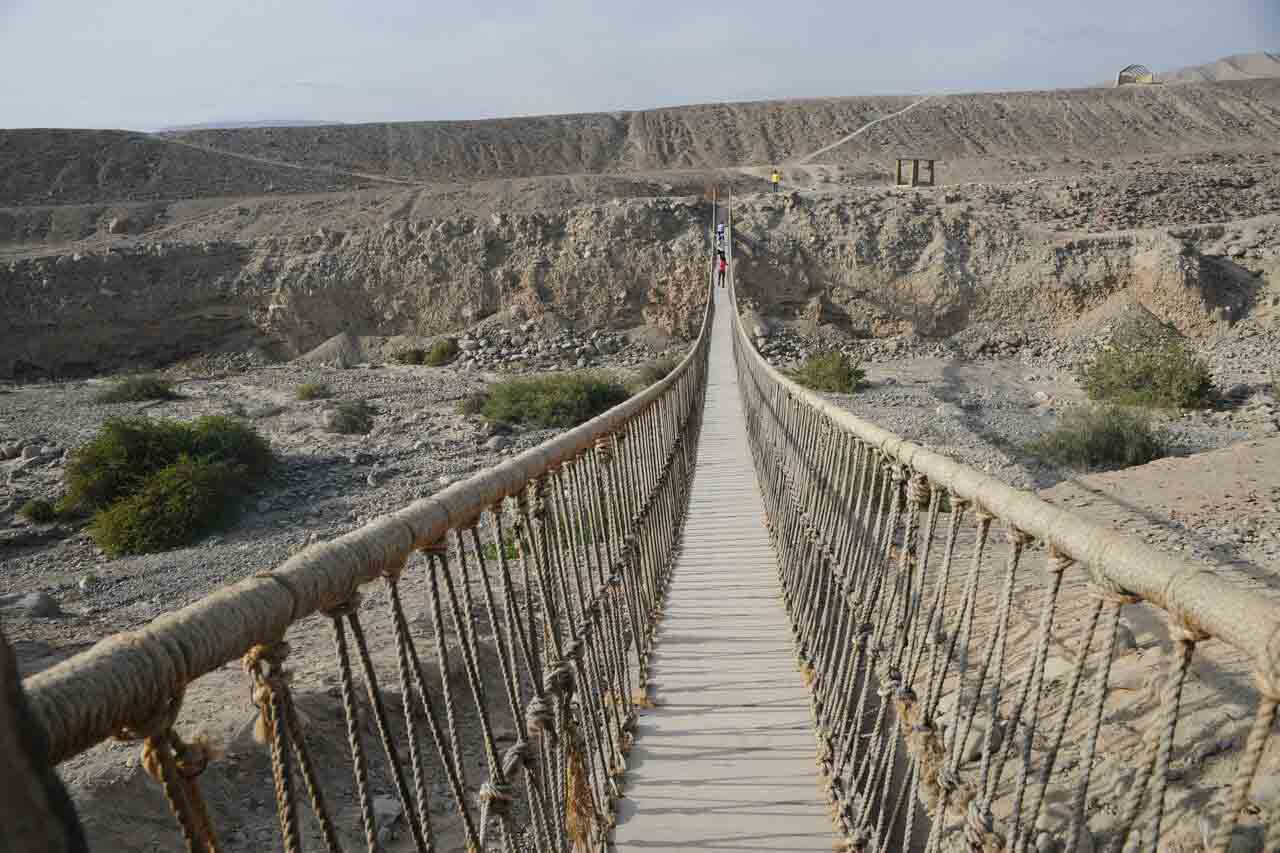
Peru's Incan Rope Bridges On The Thread of Dissapearing | Travel Blog
The Andes' ancient tradition and technology is slowly disappearing into history
As a young explorer my friend Lido (today a Peruvian Archaeologist) was guided across a tiny rope bridge that spans the Pampas River. It was his first time crossing such a bridge. The ancient technology uses twisting branches to create a crossing. The bridge, Chuschichaka was only 20 meters in length. However, it was stunning. It is a reminder of ancient times when similar bridges were built along roads and trails that connected the Inca Empire.
On his way to the village of Sarhua, arrival appeared to be close to the town of Chuschi where he began the journey that day. The rugged terrain made the journey difficult and tiring. It took several hours to walk the entire distance with the rope bridge at the middle. Finally, the team reached Sarhua, where they were greeted by the community with music, food, and dance. It was an unforgettable and memorable experience thanks to their hospitality.
As an archaeologist, Lido's mission was to find ancient terraces of agriculture in the area. As he was getting ready for work, he was informed that Tinkuqchaka was constructing a new bridge.

A few younger and older people were not staying in the town. Most community members were already heading to Tinkuy (a name meaning "a place for meeting," "a space to play," or even "a place where you fight") to participate in the bridge reconstruction. Sadly, Lido could not spare the time to attend, though he would hear all about such work later from his friend and colleague--anthropologist Cirilo Vivanco (co-author), who is originally from Sarhua. Tinkuqchaka wasn't finished when he left the community in the wee hours of the morning three days later. He crossed the bridge partially completed by flashlight holding on to the handrails.
Hanging bridges have been a practice in Peru for many years. It may be as old as the Wari culture which flourished between 600 and 1000. There were dozens of bridges that connected communities across rivers and gorges at one time. Today, only a handful of these bridges are still in existence, mostly for tourists' sake, and they are rapidly falling into disrepair. The most well-known of these, Queshuachaca located near Cuzco's former Inca capital, collapsed due to lack of maintenance.
The worldwide appreciation for the Andes' hanging bridges dates back a long time. E. George Squier, an American archaeologist, published Peru Incidents of Exploration and Travel in the Land of the Incas in 1877. He included a few pages about the magnificent hanging bridge that spans the Apurimac River, which runs from Cuzco to the north. The bridge was built in a huge valley, enclosed by steep and massive mountains. The bridge, which measured over 40m in length and was entirely made from plant materials, was suspended from huge cliffs on each side. Squier described the bridge as a "thread", a weak and swaying structure that was often crossed by animals and people, who were carrying heavy loads. The journey from the beginning of the morning to the bridge was timed by travelers before strong winds arrived, making the bridge swing "like a huge hammock."
Squier was impressed and said that crossing the bridge was an experience he will never forget. This description and the accompanying photo of the bridge caught the attention of all who read Peru. Incidents of Travel and Exploration.. Hiram Bingham, the American explorer, was famous for reporting the existence of the magnificent Inca city of Machu Picchu in 1911 to a worldwide audience. Historiographers believe that Bingham was motivated to travel to Peru because of the Apurimac hanging bridge illustration he found in Squier's book.

The Inca hanging bridges impressed Spaniards long before Squier. Early Spaniards, such as Pedro de Cieza de Leon, were fascinated. The arrival of the Spaniards was a disaster for the local Indigenous population. The Europeans brought diseases to the Indigenous peoples. Communities were reduced to a minimum or completely abandoned. The Spaniards' fascination with precious minerals like gold and silver led to the shift of Indigenous peoples' efforts to other activities. This often left them unattended to their other obligations such as building bridges.
Three years ago, Lido's first trip to Sarhua was over, and he was back, this time with the mission of registering the archeological sites around Sarhua. They crossed Tinkuqchaka and soaked in the Pampas River beneath the bridge.
He watched the bridge gently sway over the river as Cirilo explained how Tinkuqchaka was built entirely from plant material and required an annual maintenance. The total renewal had to be done every two years. He also shared the story of how the community came together to accomplish this feat, which included himself. He was able to understand the story behind this touching activity through my conversations with Cirilo.
The community of Sarhua has been divided into two groups, ayllus. This is in keeping with ancient Andean principles. The one ayllus considered local is the other, which is thought to include "outsiders", possibly descendants of Inca peoples who moved from outside the Inca realm. Both ayllus live side-by-side and it is believed that this division is necessary for maintaining the balance required for the well being of the community. Sarhua residents rarely highlight their group membership except when they are involved in communal activities such as the bridge rebuilding.

The bridge is managed by one person. This individual has been named by the community. Chakakamayuq is the title. The chakakamayuq notifies the community about the need to renew the bridge. They then begin collecting the required construction material, the branches from a bush called pichus. On a specific day, members of the community descend from Sarhua carrying pichus branches to Tinkuy.
Kumumpampa is an open space located near the bridge that serves as the gathering spot. Both ayllus are positioned at this spot, with the local ayllu being closer to Sarhua, and the outsiders being closer to the Pampas River. This location is symbolically far from Sarhua. The ayllus have to discuss logistical details and then they can exchange jokes with one another, making the entire activity a spectacle. It is not only a contest between the ayllus, but also a game. Time to joke and tease the opponents.
Both ayllus have to first produce aqaras 23 ropes measuring 100 meters from the pichus branch. Bundles made from nine pichus branches are tied and braided. The winner will be the ayllu with more ropes. Defeat is shameful and so both ayllus plan to win. While this is mostly a male activity in the majority, the women of both ayllus engage by cheering and preparing meals for their side.
The first task is to produce the aqaras. The second challenge is to make five thicker cables using the aqaras. This is a harder job. Teams from the ayllus start at the middle and work outwards, once again in competition. Younger members watch, knowing that they will soon be in charge. The winner is announced at the end and celebrated with loud shouts. Victory is joyful and sweet, while loss is painful, ugly, and anguishing.
After completing the five cables are completed, the work shifts to the river's edge, where there is a tower of stone. The outsider ayllu members cross the river to the other side using the old bridge. After that, the Pampas River carries the old bridge downstream, marking the end in a cycle and strengthening, temporarily, the separation between the outsiders.
Tinkuqchaka's renewal demonstrates the important role of the Ayllus, and the need for their reunion to ensure the community's vitality. Local ayllu members carry ropes along the riverbank, keeping one end in their own hands. This is a difficult task because bridge construction occurs during the rainy season when the river is full of water. To pull the rope across the river, the local ayllu attaches the rope to the thickest cable. These cables, made from heavy wet branches and thick ropes, are nearly as thick as one's body. It takes several hours to drag the five cables across the riverbank and tie them securely behind the stone tower at the other end.

Three cables are pulled taut and horizontally to form the base of the bridge. Small sticks are placed transversely on top and secured to the cables with cords. Two smaller cables are used as handrails.
The entire task of building the bridge takes five days. During this time, the whole community stays at Tinkuy. The days are spent building the bridge, but the evenings are for socializing, drinking, singing, dancing, and regenerating the community's sense of belonging. This bridge is a historical landmark and the community is proud to have carried on this tradition.
Tinkuqchaka's technology seems ancient. It is possible that the construction of the bridge resembles ancient practices. We don't know for certain. It is amazing that Sarhua and other communities are able to accomplish such incredible engineering and construction feats. This shows the power of collective action.
Hanging bridges could have existed before the Inca Empire. The Inca royal highway was large and had several river crossings. This suggests that bridge technology existed long before the Incas. This is not an easy possibility to prove. This time period has no documented records, and the plant material used to build the bridges did not leave any archaeological traces.
The symbol of technology that was developed in this area by our forefathers, the hanging bridge, is a significant symbol. It would be considered a monument to creativity and imagination by the Indigenous peoples in the Andes. The bridge should also be maintained as a reminder of this remarkable achievement from unknown origins. There is no perfect world and there are other priorities. According to Andean philosophy, all things have an end. Hanging bridges are no exception.
The cable bridge, which was constructed in 1992 for the residents of Sarhua effectively ended the biennial constructions of rope bridges, was built. A larger bridge, which could hold cars, was constructed in 2007. Tinkuqchaka was rebuilt for tourism in 2014. It seems that the local youth are not interested in continuing this tradition.
We are witnessing the end of something amazing, unique, and, to foreign eyes, quite spectacular. It is the end of something that was everywhere in this region. Those of us who were fortunate enough to have seen and walked on these bridges often took them for granted without realizing that we were about to witness an important chapter in Andean history.
Check Our Suggested Tours:
- Honeymoon In Peru - Peru Honeymoon Packages
- From the Heart of the Jungle to the Sacred Mountain: A Luxury Expedition Through the Amazon & Ausangate 16d/15n
- Family Adventure Tour
- Following the Path to the Sacred Sun Gate
- Peru By Belmond Tour
- The Soul of Two Worlds: A Grand Amazon & Andes Expedition 14d/13n
